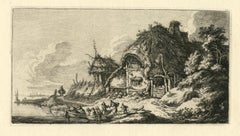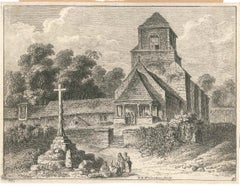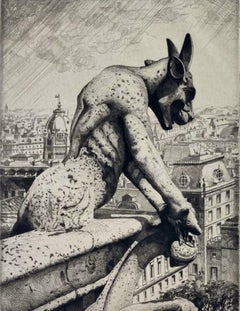Franz Edmund Weirotter Art
Austrian, 1733-1771
Franz Edmund Weirotter was a painter of landscapes, marine scenes and genre scenes. He traveled to Paris and to Rome, where he produced several paintings and etchings. Some of Weirotter's works can be seen at the Fine Arts Museums of San Francisco.
to
2
1
3
3
Overall Height
to
Overall Width
to
1
3
1
1
1
1
2
1
2
3
6,935
3,285
2,514
1,213
3
Artist: Franz Edmund Weirotter
"A Cottage" original etching
By Franz Edmund Weirotter
Located in Henderson, NV
Medium: original etching. Published in London in 1868 for P. G. Hamerton's Etching and Etchers. This impression on laid paper was printed from Weirotter's original plate. Plate size:...
Category
1860s Franz Edmund Weirotter Art
Materials
Etching
Old Church - Original Etching by F.E. Weirotter - Half of 1700
By Franz Edmund Weirotter
Located in Roma, IT
Old Church is an original artwork realized by Franz Edmund Weirotter in the first half of the XVIII Century.
Original Etching on paper. Passepartout included (cm 37 x 55).
Signed...
Category
Mid-18th Century Modern Franz Edmund Weirotter Art
Materials
Etching
Paysages (Landscapes)
By Franz Edmund Weirotter
Located in New York, NY
Franz Edmund Weirotter (1730-1771), Paysages (Landscapes), 1759, complete set of 6 (5 are illustrated on this site), [signed in the plates lower right Weirotter sc, and also signed a...
Category
1750s Realist Franz Edmund Weirotter Art
Materials
Etching
Related Items
The Gargoyle and His Quarry
By John Taylor Arms
Located in Storrs, CT
The Gargoyle and His Quarry, Notre Dame. 1920. Etching.Fletcher 90. 7 1/8 x 5 1/4 (sheet 10 1/2 x 9 1/16). Gargoyle series #1. Edition 75. A rich impression printed on 'FJHead&Co' c...
Category
1920s American Modern Franz Edmund Weirotter Art
Materials
Drypoint, Etching
House on Cliff Walk, Newport, Rhode Island
By Clifford Isaac Addams
Located in Storrs, CT
House on Cliff Walk, Newport, R.I. 1931-1932. Etching and drypoint. Hausberg catalog 13 state .i/ii. Edition 75 in this state. 5 7/8 x 7 7/8 (sheet 9 x 13 1/2). A rich impression pr...
Category
Mid-20th Century American Modern Franz Edmund Weirotter Art
Materials
Drypoint, Etching
The Pantheon in Rome: A 19th Century Etching by Cottafavi
Located in Alamo, CA
This is a 19th century architectural etching of the Pantheon in Rome entitled "Panteon di Agrippa detta La Rotonda", plate 9 from "Raccolta delle principali vedute di Roma e...
Category
Mid-19th Century Realist Franz Edmund Weirotter Art
Materials
Etching
Bailey's Beach, Newport, Rhode Island.
By Clifford Isaac Addams
Located in Storrs, CT
Bailey's Beach (Newport, Rhode Island). 1933. Etching. Hausberg 126 state v/vi. Edition 75. 6 x 7 7/8 (sheet 9 3/8 x 12 3/8). Printed with extensive plate tone with plate tone on 'Va...
Category
Mid-20th Century American Modern Franz Edmund Weirotter Art
Materials
Drypoint, Etching
The Gothic Spirit
By John Taylor Arms
Located in Storrs, CT
The Gothic Spirit (also called A Gargoyle, A Gothic Spirit). 1922. Etching and stipple. Fletcher 120. 11 5/8 x 7 (sheet 15 1/4 x 11 1/4). Gargoyle Series #8. Edition 130. Illustrated...
Category
1920s American Modern Franz Edmund Weirotter Art
Materials
Drypoint, Etching
From Knoedler's Window MCMXXXV
By John Taylor Arms
Located in Storrs, CT
From Knoedler's Window MCMXXV. 1935. Etching and Aquatint. Fletcher catalog 293 stateiv/v. Image: 5 1/16 x 4 15/16 (sheet 12/7/8 x 9 1/8). Edition 271 in this state (total edition 3...
Category
1920s American Modern Franz Edmund Weirotter Art
Materials
Aquatint, Etching
Windsor
By Sir Francis Seymour Haden, R.A.
Located in Storrs, CT
Schneiderman catalog 186 state .xii. 13 1/4 X 17 1/2 (sheet 18 5/8 x 23 1/4). Edition of 50 in this state, published by the Fine Art Society. A fine impression printed on cream wove paper with full margins. Signed in pencil. Housed in a 22 28-inch archival mat, suitable for framing.
Born in 1818, Sir Francis Seymour Haden was an etcher, collector and surgeon. He studied at the Derby School, Christ’s Hospital and University College in London. He also studied at the medical schools of the Sorbonne in Paris and at Grenoble. He became a member of the Royal College of Surgeons in 1842 and he was made a fellow in 1857. He was an honorary surgeon to the Department of Science and Art from 1851 to 1867 and in 1847 he settled into a private practice. Haden was a vice-president of the obstetrical society of London and one of the founders of the Royal Hospital for Incurables in 1850.
In 1858, Haden encouraged James McNeil Whistler to work from nature and consequently, Whistler dedicated his first set of etchings entitled “French Set”, to Haden. The etchings were printed by Auguste Delâtre in Paris and marketed, with some help from Haden, in London. In 1859 Whistler settled in London and often visited Haden’s Sloane Street home. Whistler executed a number of paintings and etchings of domestic scenes within Haden’s home, among them “Reading By Lamplight...
Category
Late 19th Century Modern Franz Edmund Weirotter Art
Materials
Etching
Caprice, or House on Cliff Walk, Newport, Rhode Island
By Clifford Isaac Addams
Located in Storrs, CT
House on Cliff Walk, Newport, Rhode Island or Caprice, Newport, Rhode Island.. 1931/33. Etching. Hausberg catalog 138 state ii. 5 15/16 x 8 (sheet 7 7/8 x 9 5/8). A rich impression ...
Category
Mid-20th Century American Modern Franz Edmund Weirotter Art
Materials
Drypoint, Etching
H 16 in W 20 in D 0.5 in
Evening - The depth of the visible -
Located in Berlin, DE
Max Clarenbach (1880 Neuss - Cologne 1952), Evening. Etching, 18 x 41 cm (platemark), 33.5 x 57 cm (frame), inscribed "Abend" in pencil at lower left, signed and dated "M. Clarenbach. 28.III.[19]09". Framed and mounted under glass.
- Somewhat browned and slightly foxed.
About the artwork
The horizontally elongated etching depicts the panoramic view of a small town as seen from the other side of the river. There are gabled houses on the left and a mighty church spire on the right. The bourgeois houses and the large religious building indicate the urban character. These buildings are rendered in dark tones to emphasise the lighter row of houses in the centre of the picture, closer to the water. The chiaroscuro contrast creates two parallel planes that open up a space for the imagination of what the city could be. The imagination is stimulated by the almost entirely dark, barely recognisable buildings, while the arm of the river leading into the city further stimulates the imagination.
However, as the silhouette of the city as a whole is reflected in the water, the parallel planes are perceived as a band of houses that stretches across the entire horizontality of the etching and seems to continue beyond the borders of the picture. The reflection has almost the same intensity as the houses themselves, so that the band of buildings merges with their reflection to form the dominant formal unit of the picture. Only the parallel horizontal hatching creates the convincing impression of seeing water, demonstrating Max Clarenbach's mastery of the etching needle.
The water is completely motionless, the reflection unclouded by the slightest movement of the waves, creating a symmetry within the formal unity of the cityscape and its reflection that goes beyond the motif of a mere cityscape. A pictorial order is established that integrates everything in the picture and has a metaphysical character as a structure of order that transcends the individual things. This pictorial order is not only relevant in the pictorial world, but the picture itself reveals the order of the reality it depicts. Revealing the metaphysical order of reality in the structures of its visibility is what drives Clarenbach as an artist and motivates him to return to the same circle of motifs.
The symmetry described is at the same time inherent an asymmetry that is a reflection on art: While the real cityscape is cut off at the top of the picture, two chimneys and above all the church tower are not visible, the reflection illustrates reality in its entirety. The reflection occupies a much larger space in the picture than reality itself. Since antiquity, art has been understood primarily as a reflection of reality, but here Clarenbach makes it clear that art is not a mere appearance, which can at best be a reflection of reality, but that art has the potential to reveal reality itself.
The revealed structure of order is by no means purely formalistic; it appears at the same time as the mood of the landscape. The picture is filled with an almost sacred silence. Nothing in the picture evokes a sound, and there is complete stillness. There are no people in Clarenbach's landscape paintings to bring action into the picture. Not even we ourselves are assigned a viewing position in the picture, so that we do not become thematic subjects of action. Clarenbach also refrains from depicting technical achievements. The absence of man and technology creates an atmosphere of timelessness. Even if the specific date proves that Clarenbach is depicting something that happened before his eyes, without the date we would not be able to say which decade, or even which century, we are in. The motionless stillness, then, does not result in time being frozen in the picture, but rather in a timeless eternity that is nevertheless, as the title "Abend" (evening), added by Clarenbach himself, makes clear, a phenomenon of transition. The landscape of the stalls is about to be completely plunged into darkness, the buildings behind it only faintly discernible. The slightly darkened state of the sheet is in keeping with this transitional quality, which also lends the scene a sepia quality that underlines its timelessness. And yet the depiction is tied to a very specific time. Clarenbach dates the picture to the evening of 28 March 1909, which does not refer to the making of the etching, but to the capture of the landscape's essence in the landscape itself.
If the real landscape is thus in a state of transition, and therefore something ephemeral, art reveals its true nature in that reality, subject to the flow of phenomena, is transferred to an eternal moment, subject to a supra-temporal structure of order - revealed by art. Despite this supratemporality, the picture also shows the harbingers of night as the coming darkening of the world, which gives the picture a deeply melancholy quality, enhanced by the browning of the leaf.
It is the philosophical content and the lyrical-melancholic effect of the graphic that give it its enchanting power. Once we are immersed in the image, it literally takes a jerk to disengage from it.
This etching, so characteristic of Max Clarenbach's art, is - not least because of its dimensions - a major work in his graphic oeuvre.
About the artist
Born into poverty and orphaned at an early age, the artistically gifted young Max Clarenbach was discovered by Andreas Achenbach and admitted to the Düsseldorf Art Academy at the age of 13.
"Completely penniless, I worked for an uncle in a cardboard factory in the evenings to pay for my studies.”
- Max Clarenbach
At the academy he studied under Arthur Kampf, among others, and in 1897 was accepted into Eugen Dücker...
Category
Early 1900s Realist Franz Edmund Weirotter Art
Materials
Etching
Fourteenth Street. The Wigwam. (Tammany Hall).
By John Sloan
Located in Storrs, CT
1928. Etching. Morse catalog 235. state ii. Image: 9 3/4 x 7 (sheet 17 1/4 x 11 3/8). From the first printing of 100 proofs by Peter Platt. There were an additional 10 printed by Er...
Category
1920s American Modern Franz Edmund Weirotter Art
Materials
Etching
New York (from Ports of America)
By Louis Orr
Located in Myrtle Beach, SC
Louis Orr, 'New York' (from the portfolio 'Ports of America', published by Yale University Press, 1928), etching, 1925, edition not stated. Signed and titled in pencil. Signed in the...
Category
1920s Realist Franz Edmund Weirotter Art
Materials
Etching
The Biggest of All; Telephone and Telegraph Building.
By Joseph Pennell
Located in Storrs, CT
The Biggest of All; Telephone and Telegraph Building. 1925. Etching. Wuerth 853. 9 7/8 x 11 7/8 (sheet 11 1/2 x 17 1/8). Edition probably 35. An atmospheric impression with plate tone, printed on antique laid paper...
Category
Early 20th Century American Modern Franz Edmund Weirotter Art
Materials
Etching, Drypoint
H 9.88 in W 7.88 in D 0.5 in
Franz Edmund Weirotter art for sale on 1stDibs.
Find a wide variety of authentic Franz Edmund Weirotter art available for sale on 1stDibs. You can also browse by medium to find art by Franz Edmund Weirotter in etching and more. Much of the original work by this artist or collective was created during the 18th century and is mostly associated with the modern style. Not every interior allows for large Franz Edmund Weirotter art, so small editions measuring 8 inches across are available. Customers who are interested in this artist might also find the work of Max Pollak, Robert Kasimir, and Leon Danchin. Franz Edmund Weirotter art prices can differ depending upon medium, time period and other attributes. On 1stDibs, the price for these items starts at $150 and tops out at $1,800, while the average work can sell for $245.
Artists Similar to Franz Edmund Weirotter
Robert Sargent Austin, R.A., P.R.E., P.R.W.S.



